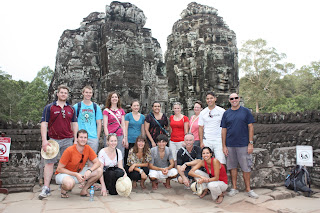The tour group
We joined the tour group in Siem Reap about 5 days ago. Our group consists of 17 people including our guide. These are australians, candians, new zealanders, an american and a brit, mostly between 25 and 32 or so, and another older couple around 60. Siem Reap is very touristy, lots of bars, shops, restaurants and markets, thai massages, foot massages on the street, fish massages, manicures, etc.
But the highlight of this place is definately the Temples of Angkhor. These temples date back to the 10th century and receive up to 3000 visitors a day in the peak season. We visited here for a day and man, are they beautiful! Huge stonework with carvings and engravings of dancers and elephants in the walls. In the temple where Lara Craft was filmed the trees have grown over and into the temples. Because we started out at 5am, we witnessed the sunrise over the temples and were able to wander around in them for hours in solitude without the crowds.
 |
| Anghkor Wat at sunrise |
 |
| Anghkor Thom |
 |
| Trees growing over the temple walls |
 |
| Wim outside Angkhor Wat Temple |
 |
| Carving of Apsara dancer on temple wall |
 |
| Trying to climb the temple stairs with the other girls...very steep.. |
 |
| walk like a cambodian..... |
 |
| cant remember which temple at sunset.. |
The next day we visited the houses on stilts near the lake (now on dry
land because its the dry season), took a boat ride to a monastery and
watched the sunrise while sipping drinks on a floating restaurant.
 |
| Tonle Sap lake and some of the house boats |
 |
| buddhist monks along the river at sunset |
 |
| Our tour guide Sarou showing us the river boundaries |
 |
| Tonle Sap lake at sunset |
 |
|
drinks with the group on the floating restaurant |
The
evening was completed by dinner with a traditional dancing show followed
by a stroll in the night market and a foot massage with the group.
 |
| Spot the south african among the dancers |
 |
| streetside foot massage |
The next day we took another long bus ride to a rural town along the
Mekong River. here we rented bicycles and cycled over a bamboo bridge.
Let me tell u something about bamboo: that shit is tough. because it was
not only our group on bicycles crossing that bridge, but tons of other
motor bikes and people and bicycles:at the same time! I had no fear for
the bamboo bridge collapsing, but because it was narrow and bumpy and
one has to peddle fast and hard in order to gain the momentum to stay
moving forward, my fear was of catapulting over the side of the bridge
into the river....my prayers saved me again and I reached the other side
safely. The rest of the cycle tour was bliss. We cycled through a
beautiful rural village island. Wooden houses on stilts set among the
green fruit trees, people waving at us, kids standing on the side of the
road shouting "hello, hello" in english and raising their hands so we
can 'high five' them as we rode past. We visited an old woman's house
and sat outside eating huge grapefruit from her tree, we also visited a
monastery or pagoda and took a stroll through the tobacco field then
watched the sunset over the river before I said my prayers again for the
bamboo bridge return trip.
 |
| the nightmarish bamboo bridge |
 |
| note the look of concentration |
 |
tobacco fields
|
The night was completed by a home dinner to a family who cooked an
amazing meal for us. We sat on reed mats on the floor and were
surrounded by bowls filled with Amok curry (traditional chicken curry
with veg), steamed rice, stir fried noodles with veg, deep fried pork
and mushrooms and grilled fish in banana leaves. After that supper we
were all exhausted and went to bed early. The next day would prove to be
quite emotionally exhausting......
 |
| Dinner at a local cambodian home |





















































